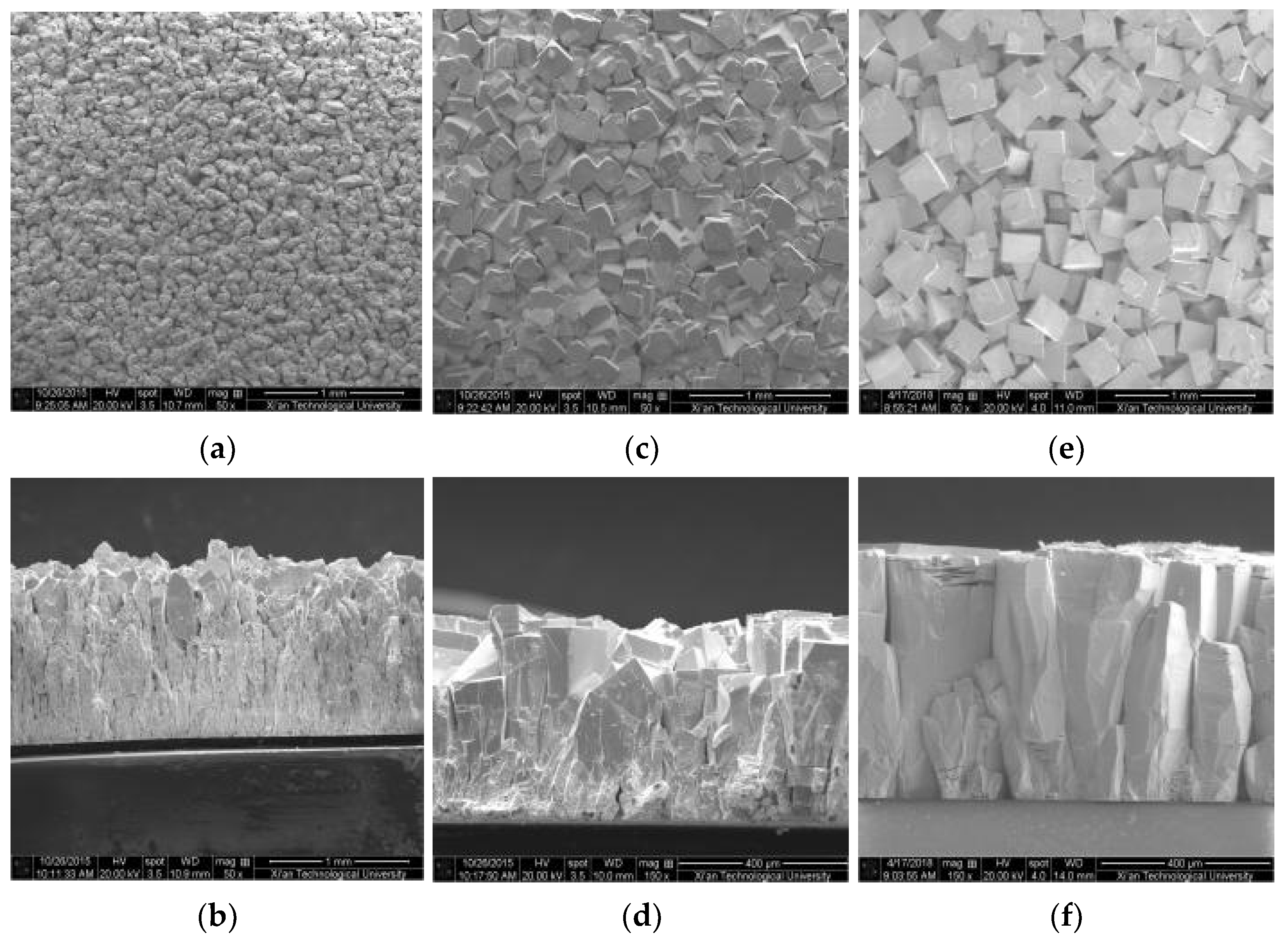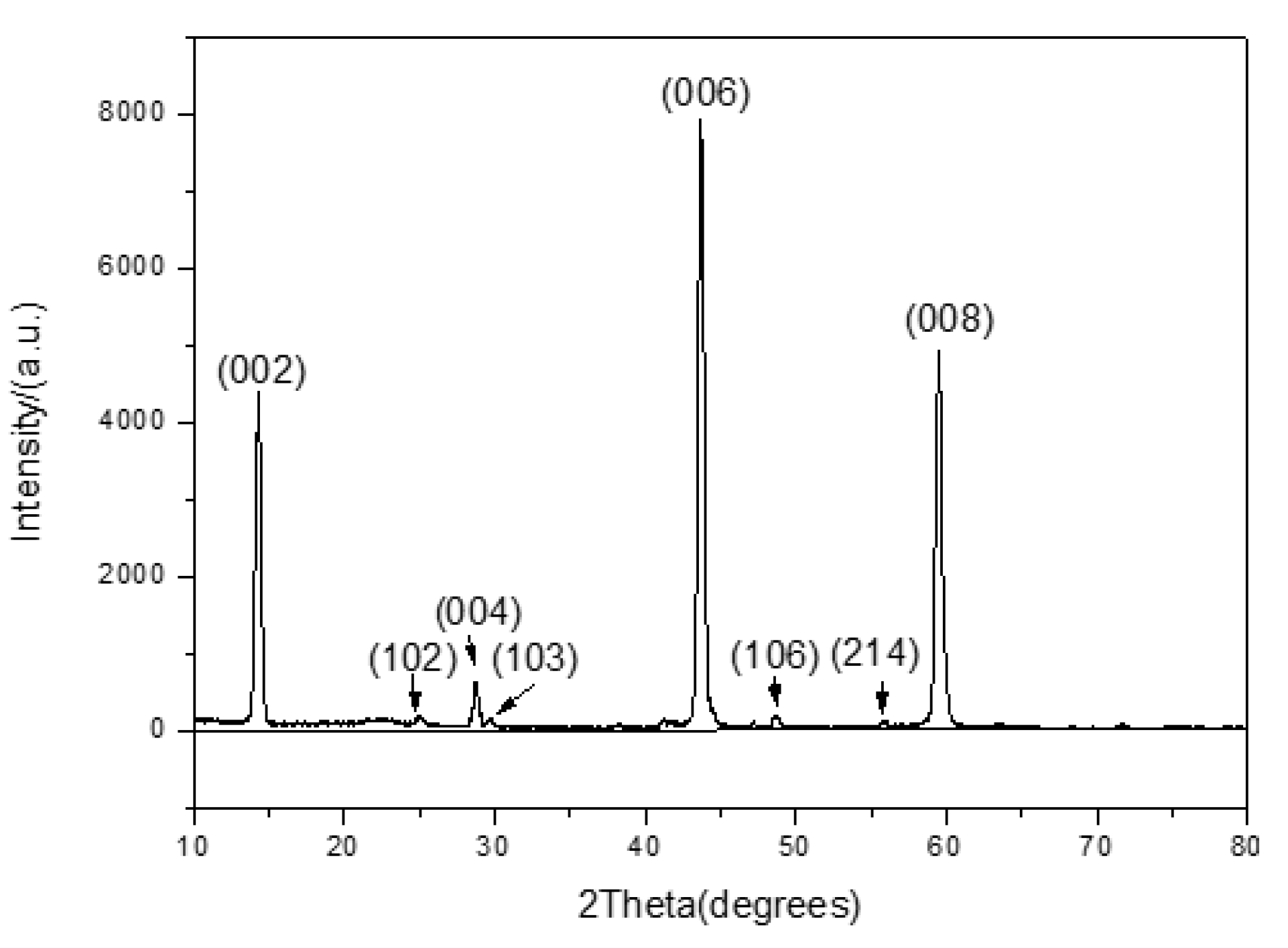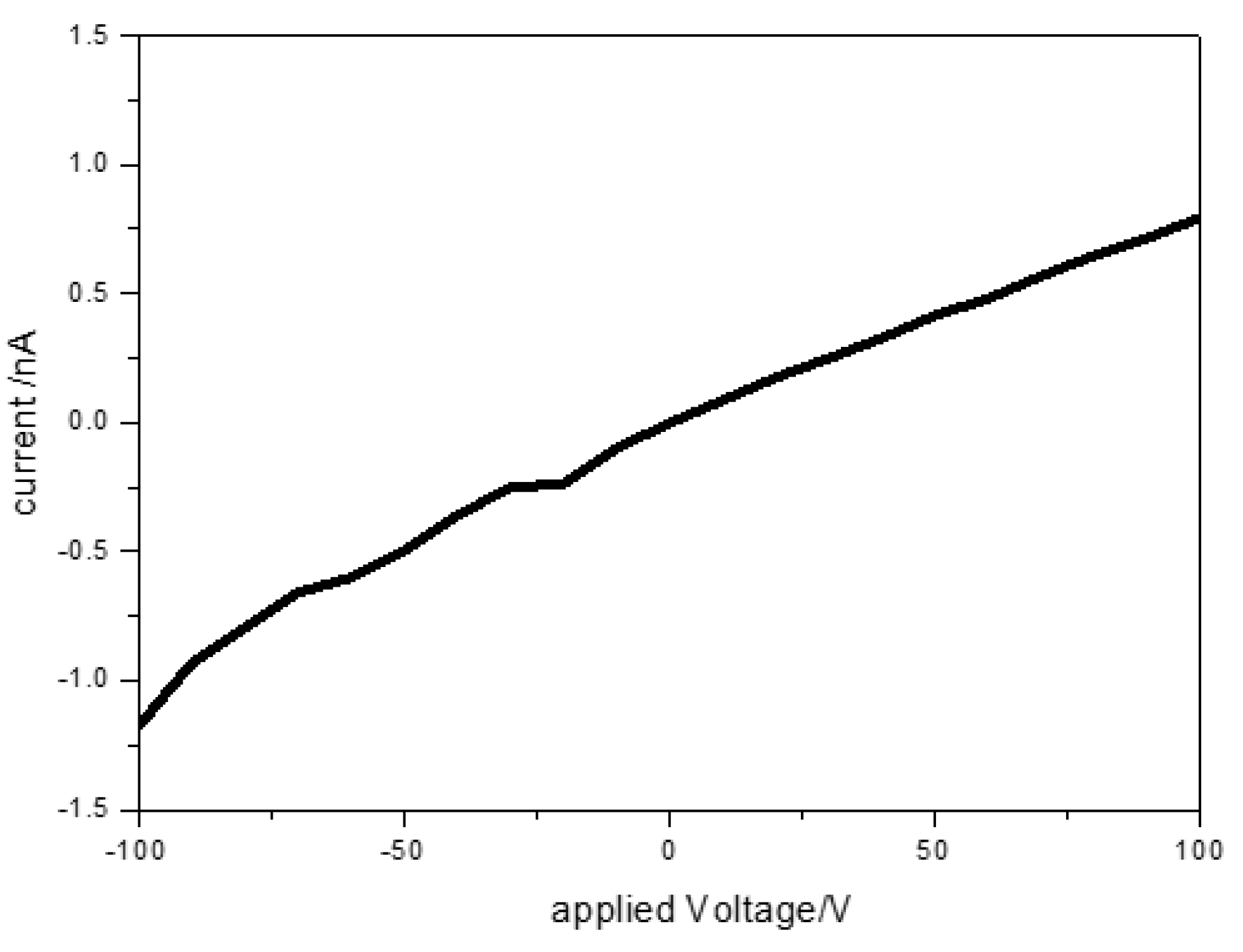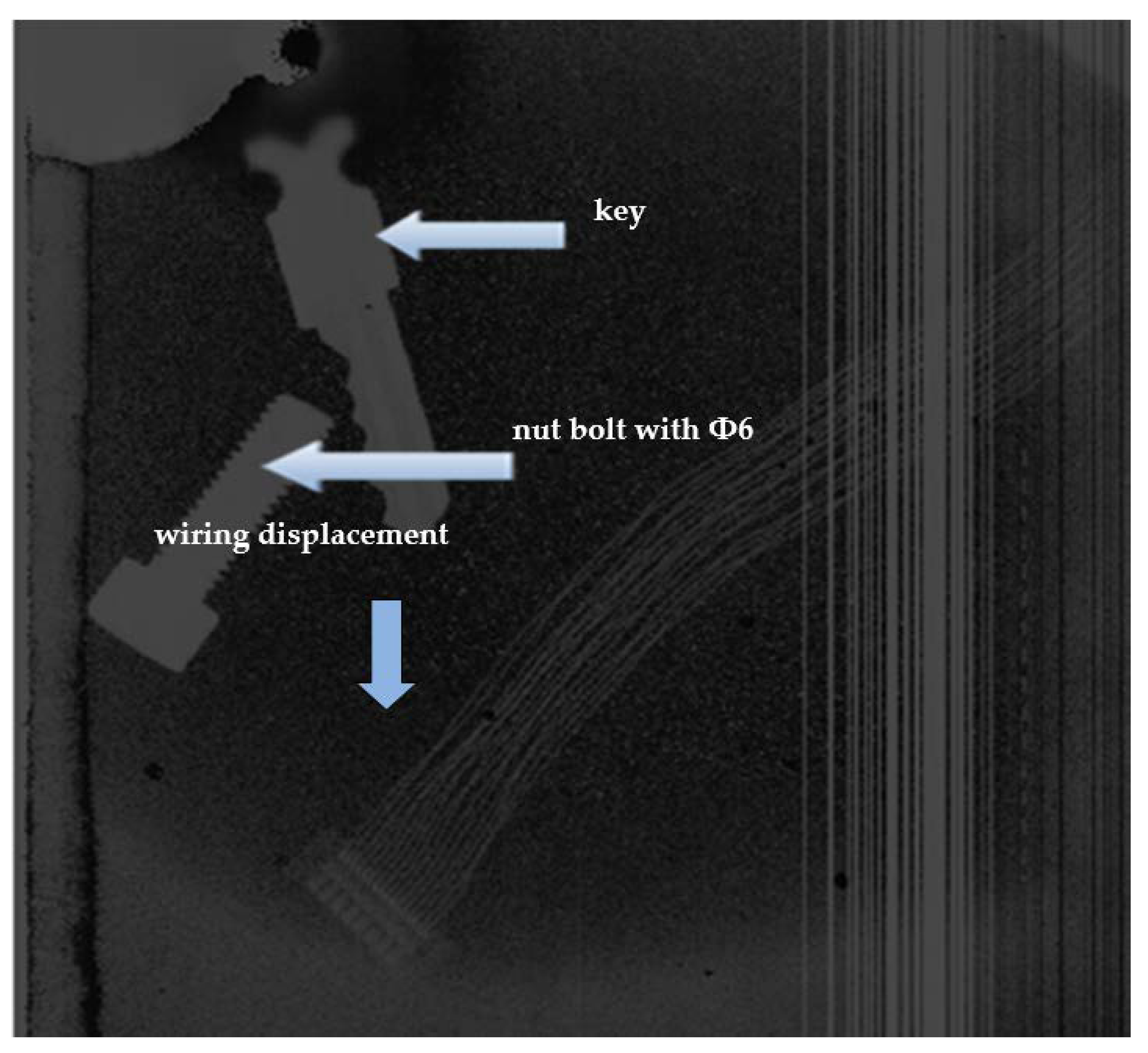Evaluation of Relationship between Grain Morphology and Growth Temperature of HgI2 Poly-Films for Direct Conversion X-ray Imaging Detectors
Abstract
:1. Introduction
2. Materials and Methods
3. Results
4. Conclusions
Author Contributions
Funding
Institutional Review Board Statement
Informed Consent Statement
Data Availability Statement
Conflicts of Interest
References
- Cha, B.K.; Yang, K.; Cha, E.S.; Yong, S.M.; Heo, D.; Kim, R.K.; Jeon, S.; Seo, C.W.; Kim, C.R.; Ahn, B.T.; et al. Structural and electrical properties of polycrystalline CdTe films for direct X-ray imaging detectors. Nucl. Instr. Meth. A 2013, 731, 320–324. [Google Scholar] [CrossRef]
- Brus, V.V.; Solovan, M.N.; Maistruk, E.V.; Kozyarskii, I.P.; Maryanchuk, P.D.; Ulyanytsky, K.S.; Rappich, J. Specific features of the optical and electrical properties of polycrystalline CdTe films grown by the thermal evaporation method. Phy. Solid State 2014, 56, 1947–1951. [Google Scholar] [CrossRef]
- Zhu, X.-H.; Sun, H.; Yang, D.-Y.; Yang, J.; Li, X.; Gao, X.-Y. Fabrication and characterization of X-ray array detectors based on polycrystalline PbI2 th ick films. J. Mater. Sci. Mater. Electron. 2014, 25, 3337–3343. [Google Scholar]
- Zhu, X.H.; Sun, H.; Yang, D.Y.; Zheng, X.L. Growth, surface treatment and characterization of polycrystalline lead iodide thick films prepared using close space deposition technique. Nucl. Instr. Meth. A 2012, 691, 10–15. [Google Scholar] [CrossRef]
- Mulato, M.; Condeles, J.F.; Ugucioni, J.C. Comparative Study of HgI2, PbI2 and TlBr Films Aimed for Ionizing Radiation Detection in Medical Imaging. Mrs Online Proc. Libr. 2011, 1341, 145–150. [Google Scholar] [CrossRef]
- Fornaro, L.; Saucedo, E.; Mussio, L.; Gancharov, A.; Cuña, A. Bismuth tri-iodide polycrystalline films for digital X-ray radiography applications. IEEE Trans. Nucl. Sci. 2004, 51, 96–100. [Google Scholar] [CrossRef]
- Cuña, A.; Aguiar, I.; Gancharov, A.; Pérez, M.; Fornaro, L. Correlation between growth orientation and growth temperature for bismuth tri-iodide films. Cryst. Res. Technol. 2004, 39, 899–905. [Google Scholar] [CrossRef]
- Jiang, H.; Zhao, Q.; Antonuk, L.E.; Elmohri, Y.; Gupta, T. Development of active matrix flat panel imagers incorporating thin layers of polycrystalline HgI2 for mammographic x-ray imaging. Phys. Med. Biol. 2013, 58, 703–714. [Google Scholar] [CrossRef] [Green Version]
- Zentai, G.; Partain, L.; Pavlyuchkova, R.; Proano, C.; Virshup, G.; Melekhov, L.; Zuck, A.; Breen, B.N.; Dagan, O.; Vilensky, A.; et al. Mercuric iodide and lead iodide x-ray detectors for radiographic and fluoroscopic medical imaging. Proc. SPIE 2003, 5030, 77–91. [Google Scholar]
- Iwanczyk, J.S.; Patt, B.E.; Tull, C.R.; MacDonald, L.R.; Skinner, N.; Fornaro, L. HgI2 polycrystalline films for digital X-ray imagers. IEEE Trans. Nucl. Sci. 2002, 49, 160–164. [Google Scholar] [CrossRef]
- Iwanczyk, J.S.; Patt, B.E.; Tull, C.R.; MacDonald, L.R.; Skinner, N.; Hoffman, E.J.; Fornaro, L.; Mussio, L.; Saucedo, E.; Gancharov, A. Mercuric iodide polycrystalline films. Proc. SPIE 2001, 4508, 28–41. [Google Scholar]
- Xu, G.; Li, J.Y.; Nan, R.H.; Zhou, W.L.; Gu, Z.; Zhang, L.; Ma, X.M.; Cao, X.P. Large area HgI2 polycrystalline films for X-Ray imager. J. Optoelectron. Adv. Mater. 2016, 18, 842–846. [Google Scholar]
- Burger, A.; Nason, D.; Franks, L. Mercuric iodide in prospective. J. Cryst. Growth 2013, 379, 3–6. [Google Scholar] [CrossRef]
- Katsis, A.; Abel, E.; Pavlyuchkova, R.; Senapati, S.; Girdhani, S.; Parry, R. Abstract 3599: Implementation of a fully automated 3D foci counting algorithm to determine DNA damage in cells. Cancer Res. 2016, 76, 3599. [Google Scholar]
- El-Mohri, Y.; Antonuk, L.E.; Zhao, Q.; Su, Z.; Yamamoto, J.; Du, H.; Sawant, A.; Li, Y.; Wang, Y. TH-C-I-611-09: Development of Direct Detection Active Matrix Flat-Panel Imagers Employing Mercuric Iodide for Diagnostic Imaging. Med. Phys. 2005, 32, 2158. [Google Scholar] [CrossRef]
- Piechotka, M. Mercuric iodide for room temperature radiation detectors. Synthesis, purification, crystal growth and defect formation. Mater. Sci. Eng. 1997, 18, 1–98. [Google Scholar] [CrossRef]
- Van Scyoc, J.M.; James, R.B.; Burger, A.; Soria, E.; Perrino, C.; Cross, E.; Schieber, M.; Natarajan, M. Electrodrift purification of mercuric iodide for improved gamma-ray detector performance. Nucl. Instrum. Methods Phys. Res. Sect. A Accel. Spectrometers Detect. Assoc. Equip. 1996, 380, 36–41. [Google Scholar] [CrossRef]
- Schieber, M.; Zuck, A.; Braiman, M.; Melekhov, L.; Nissenbaum, J.; Turchetta, R.A.D.; Dulinski, W.; Husson, D.; Riester, J.L. Polycrystalline mercuric iodide detectors. Proc. SPIE 1997, 3115, 146–151. [Google Scholar]
- Schieber, M.; Zuck, A.; Melekhov, L.; Shatunovksy, R.; Hermon, H.; Turchetta, R.A.D. High-flux x-ray response of composite mercuric iodide detectors. Proc. SPIE 1999, 3768, 296–310. [Google Scholar]
- Ugucioni, J.C.; Netto, T.G.; Mulato, M. Mercuric iodide composite films using polyamide, polycarbonate and polystyrene fabricated by casting. Nucl. Instr. Meth. A 2010, 622, 157–163. [Google Scholar] [CrossRef]
- Xu, G.; Guo, Y.F.; Xi, Z.Z.; Gu, Z.; Zhang, L.; Yu, W.T.; Ma, X.M.; Li, B. Study on growth of large area mercuric iodide polycrystalline film and its X-ray Imaging. Proc. SPIE 2014, 9298, 91–97. [Google Scholar]
- Hartsough, N.E.; Iwanczyk, J.S.; Nygard, E.; Malakhov, N.; Barber, W.C.; Gandhi, T. Polycrystalline Mercuric Iodide Films on CMOS Readout Arrays. IEEE Trans. Nucl. Sci. 2009, 56, 1810–1816. [Google Scholar] [CrossRef] [Green Version]
- Schieber, M.; Hermon, H.; Zuck, A.; Vilensky, A.; Melekhov, L.; Shatunovsky, R.; Meerson, E.; Saado, Y.; Lukach, M.; Pinkhasyc, E.; et al. Thick films of X-ray polycrystalline mercuric iodide detectors. J. Cryst. Growth 2001, 225, 118–123. [Google Scholar] [CrossRef]
- Roy, U.N.; Cui, Y.; Wright, G.; Barnett, C.; Burger, A.; Franks, L.A.; Bell, Z.W. Polycrystalline mercuric iodide films: Deposition, properties, and detector performance. IEEE Trans. Nucl. Sci. 2002, 49, 1965–1967. [Google Scholar] [CrossRef]
- Fornaro, L. State of the art of the heavy metal iodides as photoconductors for digital imaging. J. Cryst. Growth 2013, 371, 155–162. [Google Scholar] [CrossRef]
- Dryburgh, P.M. The estimation of minimum growth temperature for crystals grown from the gas phas. J. Cryst. Growth 1988, 87, 397–407. [Google Scholar] [CrossRef]
- Xu, G.; Gu, Z.; Jian, Z.Y.; Xi, Z.Z.; Liu, C.X.; Zhang, G. Study on the lowest growth temperature of mercuric iodide. J. Synt. Growth 2012, 41, 1195–1199. [Google Scholar]
- Isshiki, M.; Piechotka, M.; Kaldis, E. Vapor growth kinetics of α-HgI2 crystals. J. Cryst.Growth 1990, 102, 344–348. [Google Scholar] [CrossRef]
- Zaletin, V.M.; Lyakh, N.V.; Ragozina, N.V. Stability of growth conditions and α-HgI2 crystal habit during growing by temperature oscillation method. Cryst. Res. Technol. 1985, 20, 307–312. [Google Scholar] [CrossRef]





Publisher’s Note: MDPI stays neutral with regard to jurisdictional claims in published maps and institutional affiliations. |
© 2021 by the authors. Licensee MDPI, Basel, Switzerland. This article is an open access article distributed under the terms and conditions of the Creative Commons Attribution (CC BY) license (https://creativecommons.org/licenses/by/4.0/).
Share and Cite
Xu, G.; Yao, M.; Zhang, M.; Zhu, J.; Wei, Y.; Gu, Z.; Zhang, L. Evaluation of Relationship between Grain Morphology and Growth Temperature of HgI2 Poly-Films for Direct Conversion X-ray Imaging Detectors. Crystals 2022, 12, 32. https://doi.org/10.3390/cryst12010032
Xu G, Yao M, Zhang M, Zhu J, Wei Y, Gu Z, Zhang L. Evaluation of Relationship between Grain Morphology and Growth Temperature of HgI2 Poly-Films for Direct Conversion X-ray Imaging Detectors. Crystals. 2022; 12(1):32. https://doi.org/10.3390/cryst12010032
Chicago/Turabian StyleXu, Gang, Ming Yao, Mingtao Zhang, Jinmeng Zhu, Yongxing Wei, Zhi Gu, and Lan Zhang. 2022. "Evaluation of Relationship between Grain Morphology and Growth Temperature of HgI2 Poly-Films for Direct Conversion X-ray Imaging Detectors" Crystals 12, no. 1: 32. https://doi.org/10.3390/cryst12010032




